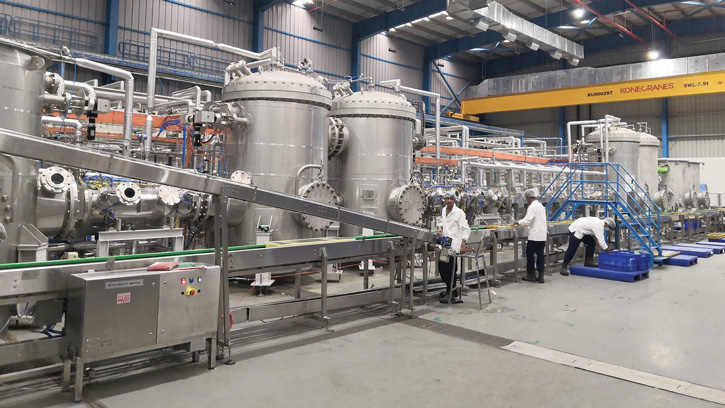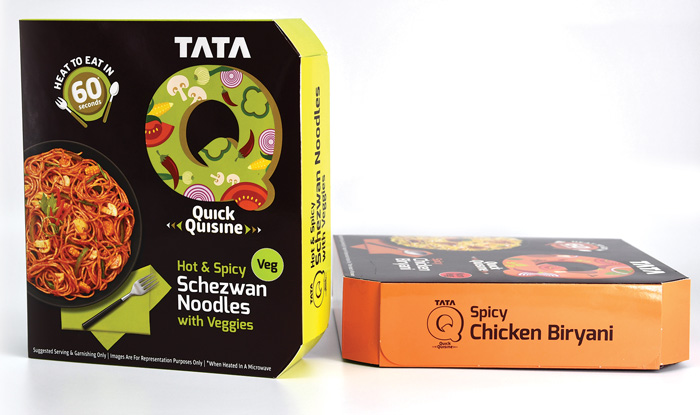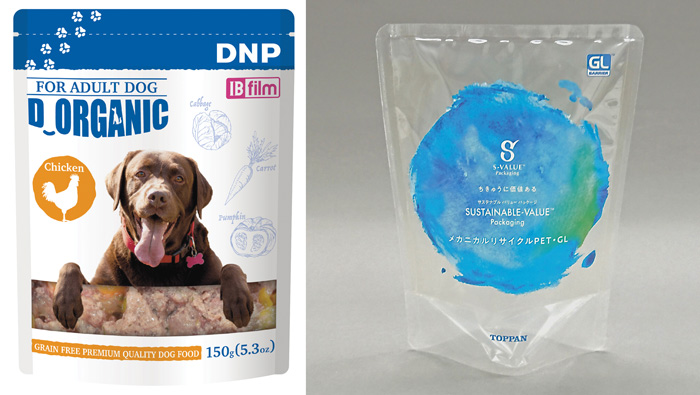Advanced Sterilization Technologies Unwrap Packaging Potential
PACKAGING
Consumers’ desire for nutritious foods and industry interest in safe, more energy-efficient, high-throughput processes have led to advanced food sterilization technologies such as microwave-assisted thermal sterilization (MATS) and pressure-assisted thermal sterilization technologies (PATS). In fact, sterilization of in-packaged foods using microwave systems has already been commercialized in Europe and Japan.
The U.S. Department of Agriculture’s National Institute of Food and Agriculture and the Department of Defense have supported the development and commercialization of microwave-based sterilization technologies. Washington State University started developing MATS in 2001 with grant support from the Defense Department’s Dual Use Scientific & Technology Program. A 915 MHz, single-mode, and semicontinuous MATS system for processing low-acid, in-packaged foods was developed at WSU, and in 2009, the U.S. Food and Drug Administration (FDA) accepted a petition to preserve homogeneous low-acid food using the WSU MATS system. WSU licensed the MATS technology in 2010 for global commercialization exclusively to a company that is now part of Tata Industries; Tata SmartFoodz operates the first industrial MATS unit at its facility in Sri City, India.
Although PATS received FDA approval of a petition to preserve low-acid food in 2009, that technology has not been commercialized because it is not yet cost-effective. But both MATS and PATS are game-changers for packaging because they fueled research and development of a comprehensive array of flexible high-barrier films that are commonly used with retort processing.
How MATS and PATS Work
The MATS system consists of four pressurized sections: preheating, microwave heating, holding, and cooling. In each section, water at a controlled temperature circulates from the individual water circulating system. The sealed food packages are transported through different water-filled sections using a conveying system (Tang 2015).
PATS differs from MATS in that both higher temperatures and pressures are required for food sterilization. For example, in PATS, pressures of 600–800 MPa and initial chamber fluid temperature of 90oC are used to ensure the inactivation of spores and enzymes. This synergistic effect of temperature and pressure helps reduce the total processing time and lowers food exposure to high temperatures compared with retort processing (Al-Ghamdi et al. 2020). Reduced food processing time helps to improve the sensory and nutritional characteristics of low-acid shelf-stable foods (Al-Ghamdi et al. 2020).
Flexibility in Packaging Materials
Many of the flexible high-barrier films used with retort processing were explicitly developed for the MATS and PATS environments. Use of flexible packaging is critical since PATS requires the package’s interface to be flexible to transmit higher pressure, eliminating the possible use of metal cans and glass jars common in retort processing. In addition, aluminum foil-laminated pouches designed to withstand the retort process are not compatible with the MATS process, and the metal layer may delaminate and blister under the influence of PATS high temperature and pressure.
Polymer-based packaging materials with superior barrier properties, such as polymeric multilayer films and pouches, are suitable for advanced sterilization technologies like MATS and PATS. Multilayer polymeric films contain two or more polymer layers combined by coextrusion, lamination, blending, and/or coating to achieve the desired gas barrier, optical, thermal, mechanical, and morphological properties for a particular food packaging application.
Multilayer Film Advantages
Significant advances in improving the gas barrier of polymeric films have been made in the past decade. Several global polymer companies, including Amcor, DNP, Kuraray, Mitsubishi, Printpack, and Toppan, have invested significantly in research and development for high-barrier polymer packaging for sterilization processes. Synthetic polymers such as polyethylene terephthalate (PET), nylons and polyamides (MXD-6 and PA), ethylene vinyl alcohol (EVOH), and polypropylene (PP) have been used to develop multilayer films and pouches.
EVOH- and metal oxide-coated PET- and PA-based multilayer films provide high oxygen and moderate to high moisture barrier characteristics. Kuraray has developed different grades of EVOH, commercially known as EVAL, for high temperature and pressure applications. Their exceptional gas barrier properties make EVAL resins an excellent choice for flexible and rigid food packaging applications. Likewise, polymer nanoclay composite has been used to prevent oxygen ingress and is suitable for the MATS processing environment.
High-barrier metal oxide-coated films provide a robust solution for the MATS and PATS environment. Because metal oxides are transparent to microwaves, metal oxide-coated PET- and PA-based multilayer films are suitable for these processes. Metal oxides such as silicon dioxide (SiO2) and aluminum oxide (Al2O3) can be used as coating materials to create multilayer films. A variety of techniques can be used for deposition of metal oxides on the PET or PA substrates, including physical vapor deposition by electron beam evaporation and sputtering, chemical vapor deposition, plasma-enhanced chemical vapor deposition, and spray coating and spinning methods. When coated with metal oxides with a typical thickness of 60–300 nm, polymers such as PET, PP, and nylons have improved barrier properties similar to those of a metalized film.
Commercially, Amcor uses SiO2 coating to produce high-barrier films suitable for MATS applications. Nippon has developed SiO2 and Al2O3 coated PET- and nylon-based very high-barrier films for food packaging applications. Another high-barrier film known as GL (Good Layer), developed by Toppan, contains SiO2/Al2O3 coating on a base film of PET. An overcoating on top of the inorganic metal oxide layer improves the flex crack resistance of GL films.
Mitsubishi Gas and Chemical and others have developed oxygen scavenger-based high-barrier packaging technology to improve food shelf life. This packaging allows oxygen-scavenging elements to absorb residual oxygen while preventing external oxygen from permeating into the package. The multilayer packaging comprises a protective layer, a metal oxide-coated barrier layer, a layer embedded with oxygen-absorbing agents, and a heat seal layer. This high-barrier packaging, coupled with advanced processing, improves food shelf life while retaining existing nutrients and texture (Patel et al. 2019).
Advancing Barrier Packaging Technologies
WSU research has significantly contributed to developing a new generation of metal oxide-based high-barrier packaging technologies, a research area within advanced sterilization technologies. For example, when research on high-barrier flexible polymer packaging started at WSU in 2007, flexible packaging compatible with this unique processing environment provided only 6 mo to 1 yr of shelf life after sterilization.
The need for an extended shelf life advanced barrier technologies considerably. New polymeric packaging with improved gas barrier properties was required for military rations and space missions that specify 3 yr and 5 yr shelf lives, respectively. Metal oxide coating used for improving the barrier properties of multilayer polymeric packaging developed pinholes and cracks after packages were subjected to MATS and PATS processes (Zhang et al. 2017, Dhawan et al. 2014). During sterilization processes, mechanical and thermal stresses caused defects in the metal oxide coating, resulting in deterioration of package gas barrier properties and compromising the food’s shelf life. Therefore, innovations in barrier technology were needed, including application of inorganic and organic barrier coating, nanocomposite materials, and blends of high-barrier polymers and standard polymers.
The WSU laboratory addressed this need with a blend of advanced analytical instruments and polymer science. For example, it employed confocal laser microscopy, scanning electron microscopy, and atomic force microscopy to probe into failure mechanisms of metal oxide–coated polymeric structures subjected to sterilization processes (Al-Ghamdi et al. 2019, Parhi et al. 2019, Zhang et al. 2017, Dhawan et al. 2014). When the laboratory found that defects decreased the barrier performance of packaging, they developed oxygen-sensitive gel systems based on agar and gellan gum to quickly detect defects in metal oxide–coated film pouches (Parhi et al. 2019). These oxygen-sensing gels can minimize the design cycle for improved performance coatings for food packaging films.
In addition, positron annihilation lifetime spectroscopy and X-ray diffraction explained how an increase in fractional free volume and crystal fragmentation and other morphological changes in polymers led to an increase in oxygen and water vapor transmission rates in polymeric packaging after sterilization processes (Zhang et al. 2017, Dhawan et al. 2014). This research has been applied to assess packaging for military rations. For example, in collaboration with U.S. Army Natick Soldier Systems Center, WSU used these techniques to assess packaging used in the MATS processing of military rations. Accelerated shelf-life testing indicated that metal oxide–coated high-barrier packaging can provide a shelf life based on nutrient and sensory attributes of at least 3 yr, depending on the chemical composition of the recipe. Such polymer-based packaging with metal oxide is a suitable alternative to foil-based multilayer packaging for shelf-stable foods (Patel et al. 2019, Zhang et al. 2017).
Semirigid Packaging
High-barrier polymer containers, e.g., trays, cups, and bowls, have drawn significant interest to replace glass jars, bottles, and metal cans for food packaging applications. Semirigid polymer trays have become standard, for example, for ready-to-eat sterilized meals. These trays are designed to have high oxygen and water vapor barrier properties, withstand high processing temperatures, and maintain their original functionality.
Due to shorter processing times, MATS is gentler on food quality and packaging compared with retort processing. This presents opportunities to reduce the environmental footprint of food and packaging processed via MATS. For example, tray wall thickness can be reduced since mechanical property requirements are less than those of conventional retort processing. WSU researchers collaborated with Kuraray America to design and develop thinner wall-thickness trays while maintaining performance, which allows for a lower-cost tray that uses less plastic in this rigid packaging. In addition, a layer of EVOH is sandwiched between PP layers to protect the EVOH from water vapor and retain its superior oxygen barrier properties. By incorporating oxygen-scavenging agents and optimizing the thickness of EVOH and PP layers, the newly designed trays showed comparable or better performance in terms of oxygen ingress, with 25% reduction in plastic used in these trays (Al-Ghamdi et al. 2020).
REFERENCES
Al-Ghamdi, S., A. Parhi, C. R. Sonar, et al. 2020. “Designing Thinner Wall Ethylene-Vinyl Alcohol Copolymer and Polypropylene-Based Semi-Rigid Trays for Microwave-Assisted Thermal Sterilization and Pasteurization Processes.” Food Packag. Shelf Life. 26: 100566. doi: 10.1016/j.fpsl.2020.100566.
Al-Ghamdi, S., B. Rasco, J. Tang, et al. 2019. “Role of Package Headspace on Multilayer Films Subjected to High Hydrostatic Pressure.” Packag. Technol. Sci. 32: 247-257. doi: 10.1002/pts.2432.
Dhawan, S., C. Varney, G. V. Barbosa-Canovas, et al. 2014. “The Impact of Microwave-Assisted Thermal Sterilization on the Morphology, Free Volume and Gas Barrier Properties of Multilayer Polymeric Films.” J. Appl. Polym. Sci. 131: article 40376 (1-8). doi: 10.1002/APP.40376.
Parhi, A., K. Bhunia, B. Rasco, et al. 2019. “Development of an Oxygen Sensitive Model Gel System to Detect Defects in Metal Oxide Coated Multilayer Polymeric Films.” J. Food Sci. 84: 2507-2519. doi: 10.1111/1750-3841.14755.
Patel, J., S. Al-Ghamdi, H. Zhang, et al. 2019. “Determining Shelf Life of Ready-to-Eat Macaroni and Cheese in High-Barrier and Oxygen Scavenger Packaging Sterilized via Microwave-Assisted Thermal Sterilization.” Food Bioprocess Technol. 9: 1516-1526. doi: 10.1007/s11947-019-02310-1.
Tang, J. 2015. “Unlocking Potential of Microwaves for Food Safety and Quality.” J. Food Sci. 80: E1776-E1793. doi: 10.1111/1750-3841.12959.
Zhang, H., K. Bhunia, N. Munoz, et al. 2017. “Linking Polymer Morphology Changes to Barrier Properties of Multilayer Films Utilized for Microwave-Assisted Thermal Sterilized Foods.” J. Appl. Polym. Sci. 134. doi: 10.1002/APP.45481.






